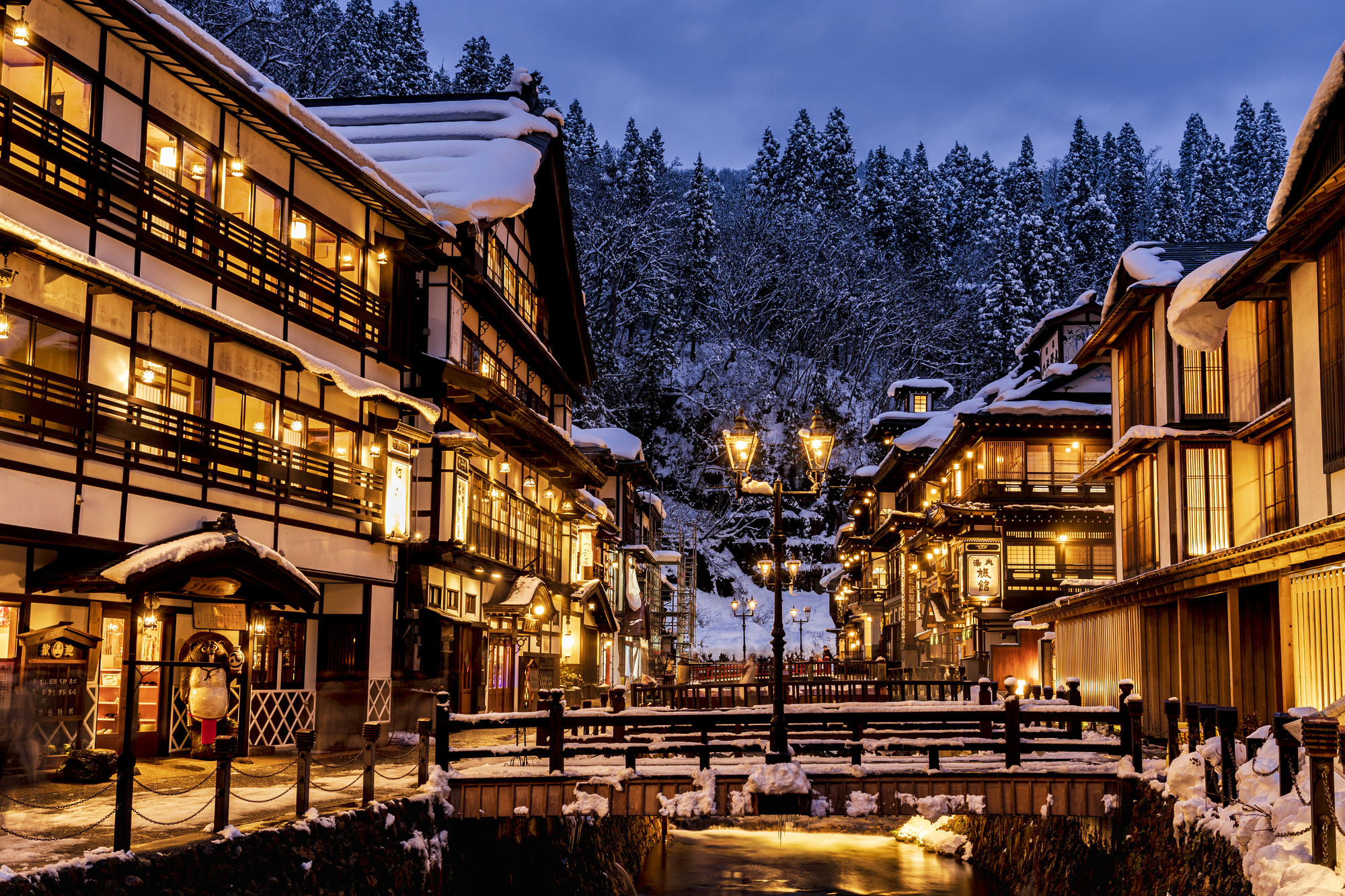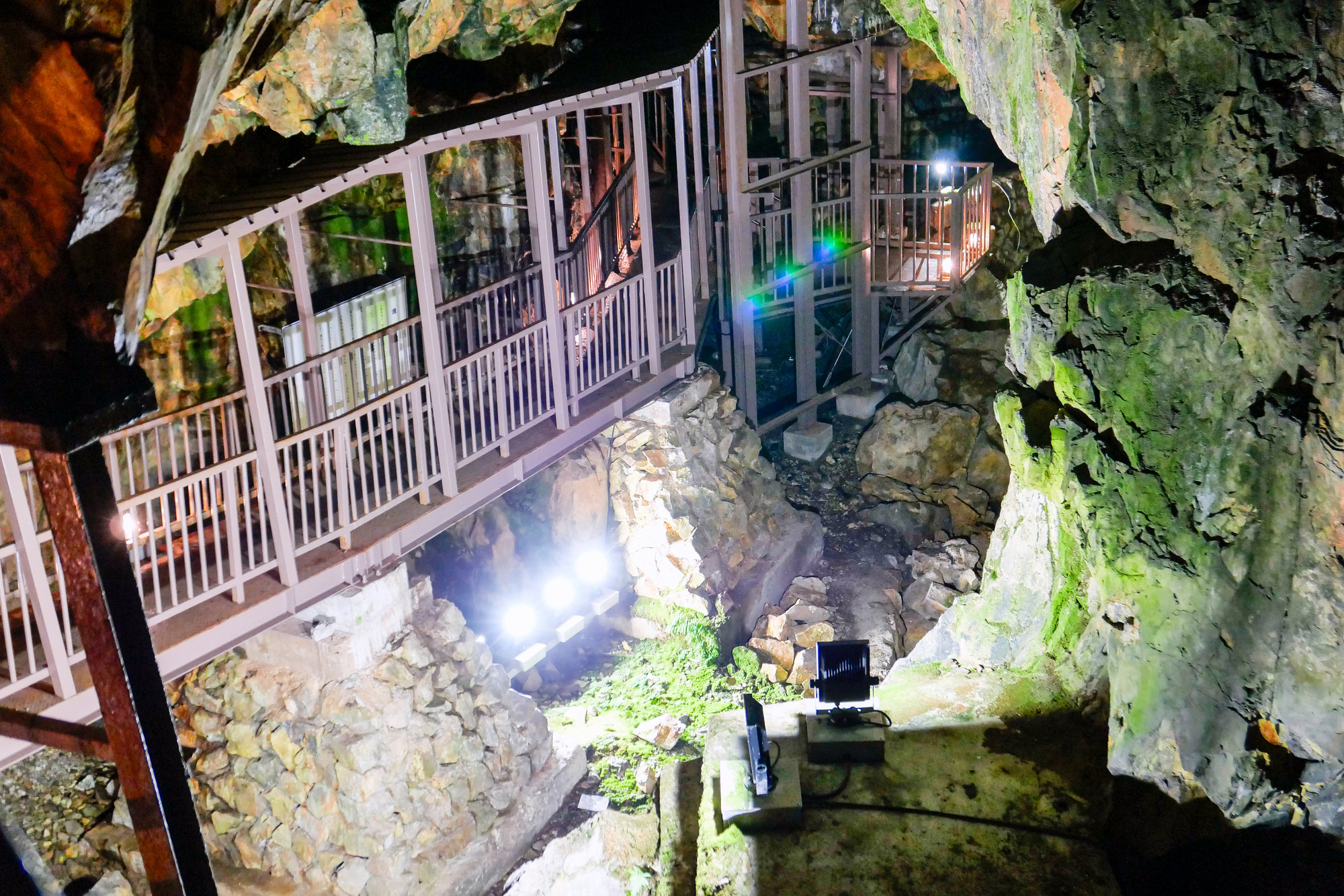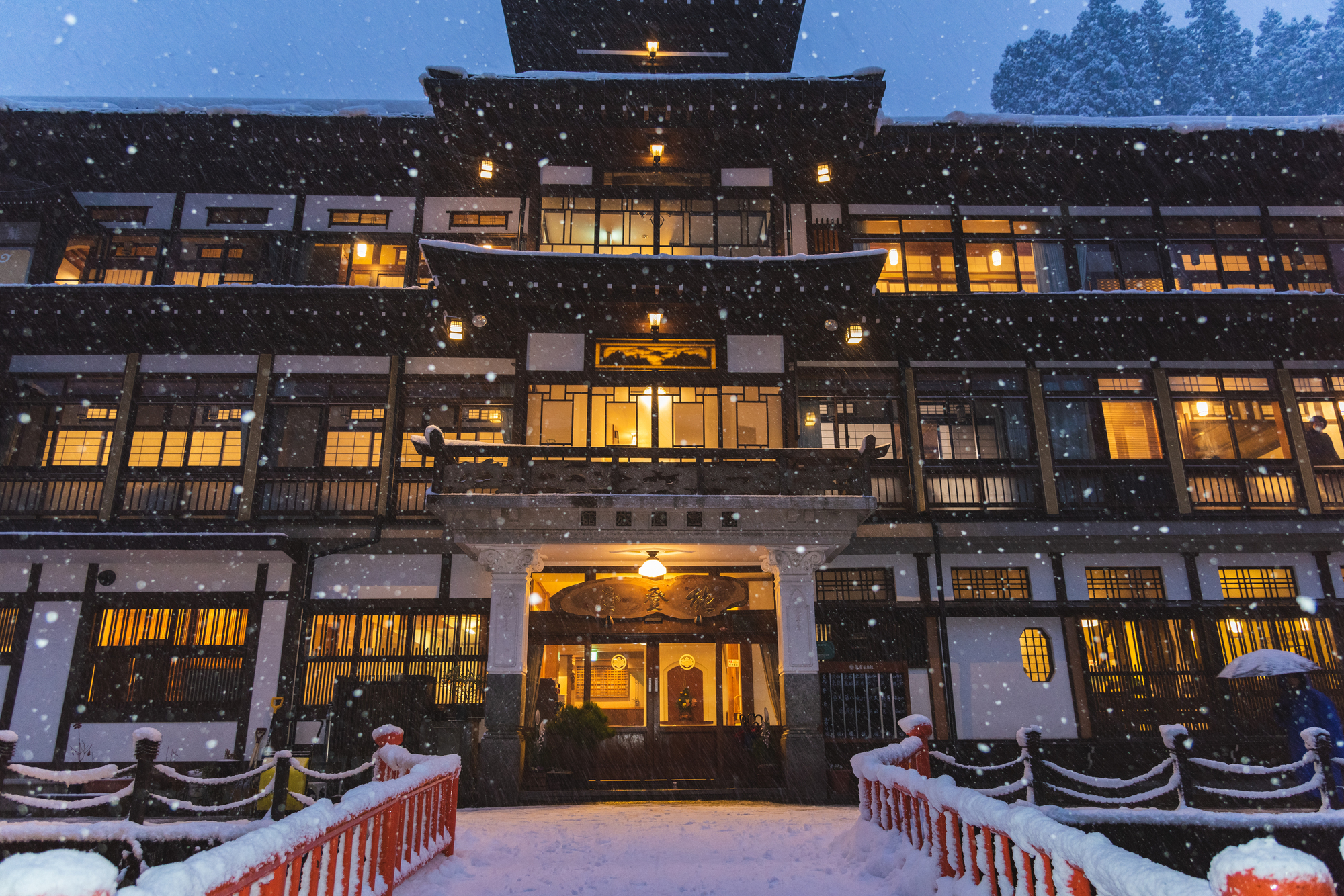Ginzan Onsen Complete Guide
Elegant Etiquette for a Taisho Roman Hot Spring Town
Table of Contents
To a Place Where Time Stands Still. Welcome to the Taisho Roman Hot Spring Town, Ginzan Onsen

With the murmur of the river as background music, the evening gas lamps begin to cast a warm, orange glow. The wooden ryokan town, covered in gently falling snow, is filled with such a nostalgic atmosphere that you might feel as if you've time-slipped to Japan of 100 years ago. This is Ginzan Onsen, a hidden hot spring nestled in the mountains of Yamagata Prefecture.
The charm of this onsen town is not just its beauty. It holds the history of a silver mine, the culture of "Taisho Roman" — a blend of Japanese and Western styles that flourished in the Taisho era — and its identity as the setting for a story that touched the hearts of people worldwide.
This guide is here to help you not only to capture that perfect photograph but also to become a "constituent" of the unique atmosphere of this place. The beauty of Ginzan Onsen is a delicate work of art, created by its historic buildings, nature, and the conduct of every person who visits. The manners introduced here are not rules, but elegant promises to cherish this artwork together and to preserve and pass it on to the future.
Now, let's forget the hustle and bustle of daily life and prepare for a journey to a bygone good era. A special time that will light a warm glow in your heart awaits you.
1.From Silver Mine to Hot Spring: A History Illuminated by Gas Lamps
Why did such a picturesque onsen town emerge deep in these mountains? The background lies in the rise and fall of a silver mine and the stories of people who embodied the spirit of their time.
1-1. The "Nobesawa Ginzan" that Flourished in the Edo Period: The Roots of the Onsen's Discovery

The history of Ginzan Onsen, as its name suggests ("ginzan" means silver mine), begins with silver. Discovered in the Muromachi period, the "Nobesawa Silver Mine" was its origin, flourishing greatly in the early Edo period as a mine under the direct control of the shogunate. At that time, it was counted as one of Japan's three major silver mines, but eventually, silver production declined, and the mine closed. However, because the miners had discovered hot springs while digging for silver, it continued its history quietly as a "toji-ba" (a place for hot spring therapy).
1-2. Modern Architecture of the Taisho Era: Why This Landscape Was Born
The current landscape of the onsen town was formed from the Taisho era (1912-1926) to the early Showa era. The Taisho era was a time when a unique and glamorous culture called "Taisho Roman" was born, blending Western culture with Japanese tradition. In Ginzan Onsen, after a great flood devastated the town, the efforts of the local people led to the construction of ryokans (Japanese inns) with three or four-story wooden balcony architecture, which was modern for the time. This became the prototype of the onsen town that still fascinates us today.
1-3. The Nostalgia the World Fell in Love With: As the Stage for the Timeless Drama "Oshin"
A major catalyst for Ginzan Onsen becoming internationally known was the 1983 Japanese television drama "Oshin," which became popular in over 60 countries. This onsen town was used as the location for the moving scene where the protagonist, Oshin, reunites with her mother. Oshin's image, thinking of her mother amidst the snowy landscape, combined with the nostalgic scenery of the onsen town, was deeply engraved in many people's hearts as a quintessential Japanese landscape.
1-4. [2025 Update] Efforts to Preserve the Scenery and New Ways to Enjoy
In Ginzan Onsen, strict ordinances are in place to protect the precious Taisho-era landscape. Even when constructing new buildings, they are required to have designs that blend in with the surrounding scenery. In recent years, cafes and souvenir shops renovated from vacant houses have increased, expanding the pleasures of strolling. Furthermore, to maintain the scenery while providing a more comfortable stay, each ryokan is also modernizing its interior, aiming for a fusion of tradition and comfort.
2.Preparations & Basic Info: Navigating the Small Onsen Town Smartly
Because it's a compact onsen town, prior information gathering can make a huge difference in the quality of your trip.
2-1. Complete Access Guide from Tokyo/Yamagata

- Shinkansen + Bus (Recommended Route): From Tokyo Station, take the Yamagata Shinkansen to "Oishida Station" (approx. 3 hours 20 mins). From Oishida Station, take the local bus "Ginzan Hanagasa-go" and get off at the final stop, "Ginzan Onsen" (approx. 40 mins).
- From Yamagata Airport: Using the reservation-based shared taxi "Oishii Yamagata Airport Kanko Liner" is convenient.
- Note: The bus from Oishida Station has limited services. Be sure to check the Shinkansen arrival times and bus departure times in advance and plan accordingly.
2-2. How to Walk Around the Town: Photo Spots, Footbaths, and Day-Use Onsen Tips
- Photo Spots: The path leading from the entrance of the onsen town to the back, the red bridges, and the view overlooking the entire town from a ryokan window are all picturesque.
- Warashi-yu Footbath: A free public footbath located in the center of the town. It's perfect for warming up your cold feet from strolling. Don't forget to bring a towel.
- Day-Use Onsen: There are public baths and ryokans that accept day-use visitors. However, hours are limited, so it's good manners to check their availability in advance.
2-3. Winter Clothing and Vehicle Restrictions: Precautions for the Most Beautiful Season
- Clothing: Winter in Ginzan Onsen is very cold with heavy snowfall. Full winter protection is necessary. Especially for footwear, non-slip, waterproof snow boots are essential. Hand warmers and other cold-weather gear are also helpful.
- Vehicle Restrictions: During winter (around December to March), the onsen town is closed to general vehicle traffic for safety reasons. It is very important to check the official Ginzan Onsen website or each ryokan’s website in advance for details and the latest information.
3.[Crucial] Creating the Atmosphere Together: 6 Manners to Keep in Ginzan Onsen
The magical atmosphere of Ginzan Onsen is protected by the behavior of every single visitor.
3-1. The Path is a Stage for Courtesy: Demeanor in the Narrow Onsen Town
The streets of the onsen town are very narrow, and even more so in winter with the snow. Avoid stopping in the middle of the road to take pictures or blocking the path with a group. The bridges are great photo spots, but a spirit of "yuzuriai" (yielding to others) is important to always be mindful of letting others pass. Cultural Context: The spirit of "Ichiza Konryu" in hospitality. In the Japanese tea ceremony, there is a term "Ichiza Konryu." It means that the host and the guests come together as one to create a wonderful atmosphere for the occasion. In Ginzan Onsen, it is expected that the ryokan staff, shopkeepers, and travelers all work together to cherish the atmosphere of the place. |
3-2. Yukata is the Town's Dress Code: Wear it with Style and Walk with Grace
When staying at a ryokan, you can stroll through the onsen town in a yukata (light cotton kimono). This is one of the great charms of Ginzan Onsen. When wearing a yukata, avoid walking with large strides or being loud, and try to behave gracefully in a manner that suits the atmosphere. On snowy roads, wearing the snow-geta (wooden clogs) or boots provided by the ryokan is both safe and charming. Cultural Context: The meaning of yukata and the appropriate conduct. Yukata were originally relaxing wear for after a bath, but in an onsen town, they also have a "fashionable" aspect. There is an underlying aesthetic in Japan that when one wears beautiful attire, one should also behave in a manner befitting it. |
3-3. The Gas Lamps are the Main Act: The Consideration of Not Using a Flash
At dusk, when the gas lamps are lit, the onsen town is enveloped in a fantastical atmosphere. To avoid spoiling the mood of this warm and somewhat ephemeral light, please refrain from using a flash when taking photos. By adjusting your camera settings, you can take beautiful pictures without a flash. Cultural Context: The Japanese aesthetic of light and shadow in "In'ei Raisan". In Japan, there is a traditional aesthetic called "In'ei Raisan" (In Praise of Shadows), which finds beauty in the shadows created by faint light rather than in strong light. The light from the gas lamps perfectly embodies this aesthetic. It's important to be considerate not to erase this delicate art of light and shadow with a bright flash. |
3-4. A Ryokan is a Home for its Guests: Pay Respect and Enter and Exit Quietly
The ryokan buildings lining the onsen town are beautiful subjects themselves, but they are private spaces where guests are relaxing. It is bad manners for non-guests to enter the lobby or buildings without permission. Even when taking photos from the outside, do so quietly so as not to disturb the guests. Cultural Context: The relationship between "guest" and "host" in Japanese inns. In a Japanese ryokan, a guest is not just a customer but a "guest" whom the host entertains with all their heart. It's an unspoken rule for visitors to show respect to the host and guests of the house and not to enter the property (building) without reason. |
3-5. Protecting the Beauty of a Small Town: Cooperating for a Spotless Landscape
The beauty of this small onsen town is maintained by the daily cleaning efforts of its residents. Never litter with food wrappers or cigarette butts; dispose of them in designated trash cans or take them with you. Cultural Context: The consciousness of "kejime" in maintaining community aesthetics. In Japan, there is a concept of "kejime," which means making a clear distinction between public and private, and between what should and should not be done. Not littering in a public space is considered a minimum "kejime" as a member of society. |
3-6. Memories in Your Heart and Photos: Prohibition of Unauthorized Drone Flights
Flying drones in the narrow onsen town is strictly prohibited as it can lead to accidents involving tourists or buildings, and invade privacy. Please capture the wonderful scenery with your own eyes, your heart, and your camera. Cultural Context: The Japanese value of prioritizing safety and harmony. Prioritizing public safety and community harmony above all else is a value deeply rooted in Japanese society. The prohibition of drones is a rule that reflects this value. |
4-1. A Nostalgic Stroll: From Shirogane Falls to the Mine Adit
At the back of the onsen town is the 22-meter high "Shirogane Falls," whose powerful appearance contrasts with the calm atmosphere of the town. Further on, there are the remains of the "Nobesawa Silver Mine" adit, a small part of which can be explored. A walk tracing the roots of Ginzan Onsen is also a delight.
4-2. Savoring Onsen Town Gourmet: Specialty Curry Bread and Stand-up Tofu
![5-1. [Day Trip] Visiting from Takayama! Shirakawa-go Highlight Course](/library/689c2e896e58203ab69c5bd3/68c11306c250fc7d126ad924.jpg)
Haikara-san no Curry Pan
4-3. The View You Only Get by Staying: A Special Time Spent at a Ryokan
To fully appreciate the charm of Ginzan Onsen, an overnight stay is recommended. You can have the fantastical scenery of the quiet night, with only the light of the gas lamps illuminating the snow, all to yourself. Furthermore, the ryokan's cuisine, which makes lavish use of local seasonal ingredients, will become the best memory of your trip.
5.Planning Your Trip: Model Itineraries to Immerse in Taisho Roman
5-1. [Day Trip] Visiting from Yamagata! A Heart-fluttering Stroll in Ginzan Onsen
- Morning: Take the train and bus from Yamagata Station via Oishida Station to Ginzan Onsen.
- Noon: Upon arrival, have a lunch of specialty soba noodles at a restaurant in the town.
- Afternoon: Stroll through the onsen town. Soak your feet in a footbath, eat curry bread. Taking a bath in a public bathhouse is also a good idea.
- Evening: Burn the magical twilight scenery with the lit gas lamps into your memory, and take the bus to Oishida Station.
5-2. [1 Night, 2 Days] Staying at a Longed-for Ryokan! A Luxurious Course to Revel in the Gas-lit Night
- Day 1:
〇 Around 15:00: Check into the ryokan. Drop off your luggage and change into a yukata.
〇 Evening: Stroll through the onsen town before sunset. Walk up to Shirogane Falls.
〇 18:00: Return to the ryokan for dinner.
〇 Night: Stroll again through the fantastically glowing, gas-lit onsen town. Later, warm up thoroughly in the ryokan's onsen.
- Day 2:
〇 Morning: Take a walk in the quiet morning onsen town before breakfast.
〇 Forenoon: Spend time at the ryokan until check-out, or go out to look for souvenirs.
〇 Around Noon: Head to Oishida Station by bus and begin your journey home.
The Warm Light to Carry in Your Heart

What you take home from your trip to Ginzan Onsen should not be just beautiful photos or delicious souvenirs. It should be a warm and gentle memory that resides in your heart, like the soft glow of a gas lamp on a snowy night.
The magical atmosphere of this place is created not only by its history and buildings but also by the quiet consideration of every visitor who thinks, "I want to cherish this beautiful scenery." If you join this circle of consideration, the light of Ginzan Onsen will surely continue to illuminate the hearts of travelers forever.

